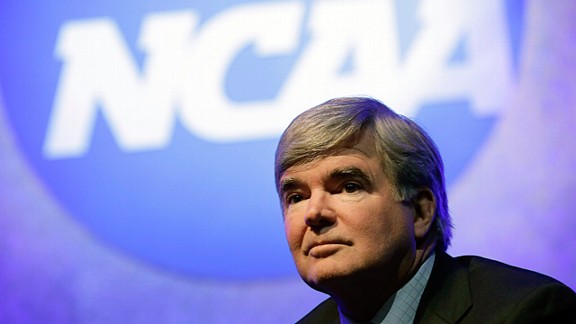Good progress report:
Ed O'Bannon v. NCAA class certification hearing: What's at stake?
The email popped in late last week from colleague Stewart Mandel: "If I'm understanding this correctly, from the court's calendar, all of these lawyers are expected to attend Thursday's hearing," Mandel wrote. "Will there be room in the courtroom for anyone else?" What followed was a list of more than 100 attorneys, each representing a plaintiff, a defendant or some interested party in the Ed O'Bannon v. NCAA case currently pending in the Northern District of California. This cavalcade of J.D.s will pack a courtroom in Oakland, Calif., on June 20 to argue whether the O'Bannon case should go forward as a class action lawsuit.
SI.com legal analyst Michael McCann has broken down the legal concepts each side will try to prove in Judge Claudia Wilken's courtroom, but we laypeople have only one question: What does this mean for the NCAA and college athletes?
The immediate answer is: nothing. Wilken probably won't issue a ruling until later this summer on whether to certify the class. The arguments Thursday will help inform that ruling, but so will reams of motions and evidence filed during the course of the case. Wilken has several options, and while all could result in a financial hit for the NCAA, only one has the power to fundamentally change the business model for major college sports.
Let's get a few things clear before we proceed. No matter what happens, this case will not end college sports. Major Division I conferences will not suddenly stop offering athletic scholarships. In the real world, people don't simply walk away from multibillion-dollar businesses. In most of the potential outcomes, the NCAA will continue to operate in a fashion similar to the way it operates now. Even in the complete nightmare scenario for the NCAA, some organization will still exist to govern major college sports. It will probably still be called the NCAA. But this case does have the power to change some of the core rules, and those changes could have a profound effect on college sports.
That last possibility is why so many lawyers are working on this case. The plaintiffs' attorneys view the NCAA as a poor man's Big Tobacco. A direct hit on the NCAA would mean a massive financial score and significant prestige. That's why firms have invested millions into this case since it was filed in 2009. While it may seem as if O'Bannon and his fellow plaintiffs are David, from a legal firepower standpoint, they are actually Goliath in this analogy. But those law firms don't recoup their investments unless they manage a huge settlement or judgment. That fact could become quite important depending on what Wilken decides about class certification.
.
.
.
continued
.
.
.
But that isn't all this case is about. Wilken changed the game in January when she ruled that current college athletes could join the suit and that athletes could go after a cut of the money the NCAA and the conferences receive for the broadcast rights to college sporting events. Television has become the main economic driver in college sports, thanks in part to a lawsuit against the NCAA -- by the schools themselves -- in the early 1980s. Now, instead of this case strictly being an NCAA issue, it also is an issue for all of the conferences. With the class certification decision, Wilken has the opportunity to either continue down this much broader road or walk the case back to its original circumstances.
Wilken has three choices:
1. She can deny the plaintiffs' motion for class certification.
2. She can certify the class for only the former players.
3. She can certify the class for former and current players.
Those first two options are probably the least expensive for the defendants. If Wilken doesn't certify the class at all, individual athletes will have to bring their own suits. The NCAA likely would have to settle quite a few cases, but the organization would not die by a thousand paper cuts. If Wilken only certifies the class to include former players, the NCAA probably would have to fork over a significant settlement. This probably is preferable to going to trial, where a judgment against the NCAA could result in punitive damages, which, under federal antitrust law, would be tripled. But the NCAA has a war chest for precisely this sort of thing. It would be fine in this situation.
The third option is the nuclear option. This is the one over which all those attorneys have salivated. Bringing in current players means bringing in current TV deals. All those contracts with ESPN and Fox that the major conferences nearly tore themselves to pieces over? They'd be in play. Conference networks for the Big Ten, Pac-12 and SEC? They'd be in play. McCann writes that this option probably would induce a settlement, but I'm not so sure. Bringing all these elements into the mix would cause a severe spike in the price of a settlement. Had the NCAA and conferences gone to the plaintiffs after the January ruling and offered to set aside a modest cut of the annual profits for athletes -- payable upon graduation -- the plaintiffs probably would have settled. If this happens? The plaintiffs will ask for the moon.
.
.
.
continued
Read More:
http://sportsillustrated.cnn.com/co...130619/ed-obannon-ncaa-hearing/#ixzz2WheLBlWi






